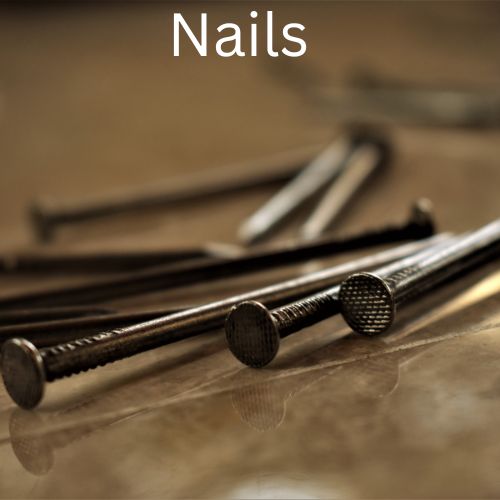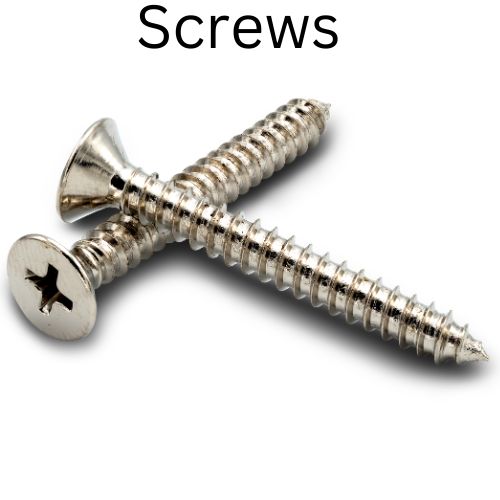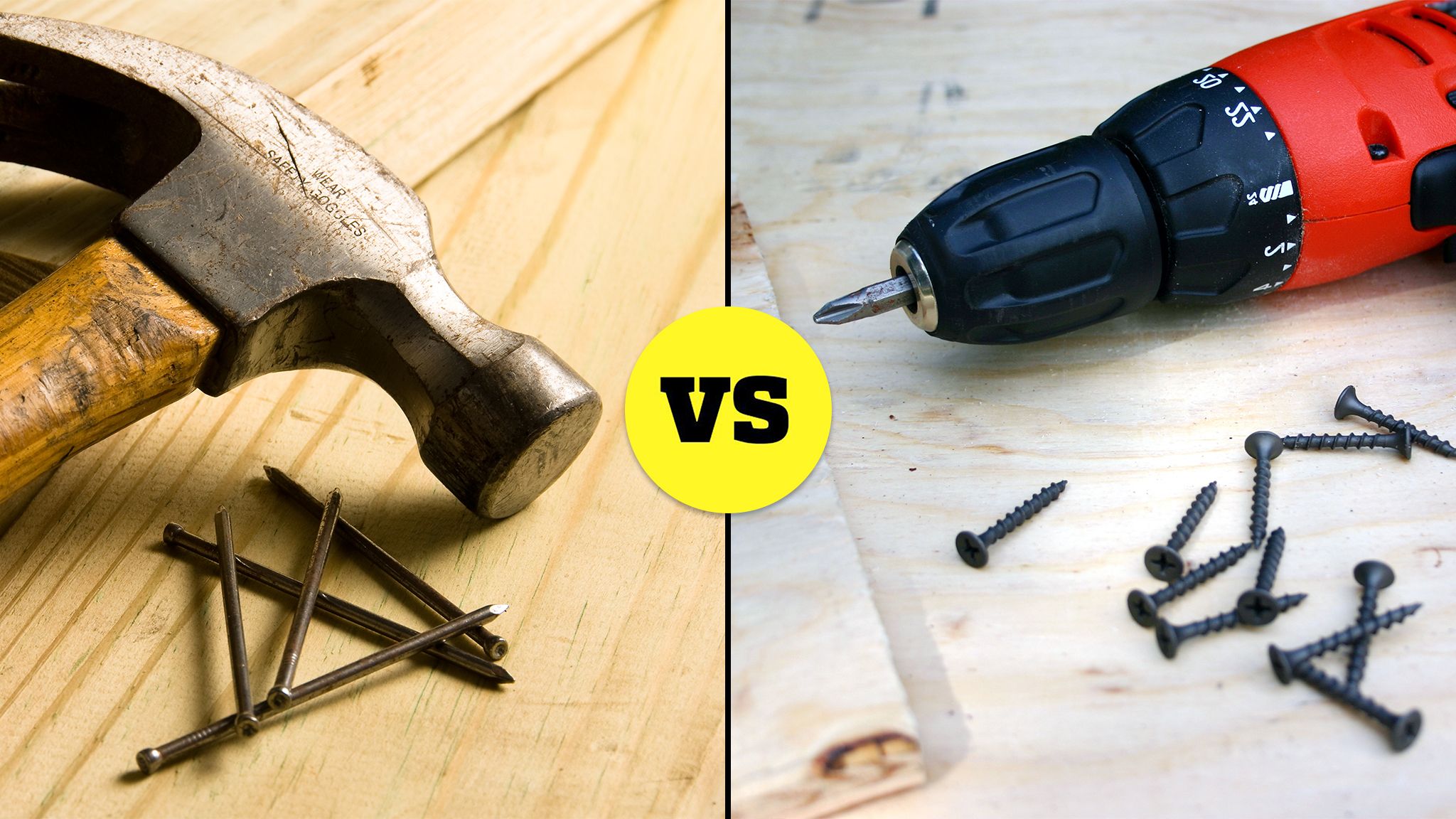Both nail guns and screw guns are some of the most popular fasteners used in construction. They are both incredibly versatile and can be used for a variety of applications. But when it comes to framing, both have different uses and benefits. In this article, we will dive deep into this very interesting topic – nails vs screws for framing.
It can be confusing which one to use since they both serve the same purpose, but it is important to know the difference so that your project turns out just the way you want it.
Let’s have a fight between nails vs screws in this article so that you can make the best decision for your next framing project.
Nails for Framing
Nails that function with framing nailers are available in several diameters and lengths. They are only suited for three nail head varieties. Now, let’s learn some important things about using nails for framing.
Why Use Nails Instead of Screws for Framing?
Framing works need to be incredibly sturdy since the whole structure of the house or building will be resting on it. Nails offer flexibility, work great under pressure, and are ideal for framing projects.
Even wonder, framing nail guns comes with different angles such as from 15-degree to 34-degree.
The first thing is that the angle degree signifies the nail collation and more precisely the angle of the magazine. Secondly, nails are always driven straight or uprightly into a surface.

Nails can also bend easily with just a little bit of force. This is helpful because it means that if the frame gets hit with something, the nails will bend instead of breaking.
You also make the joints sturdier by bending the nails. This is important because it means that the frame will be less likely to come apart if it gets hit or bumped.
What Nails to Use for Framing?
There are a lot of different types and sizes of nails, so it can be confusing to know which ones to use. There are mainly 4 types of nails that are used in framing projects:
Common Nails
These nails are usually the first choice for most framing projects. They are about 2-3 inches long and have a smooth, round shank.
The head is usually slightly larger than the diameter of the shank. The heavy shank gives sturdy support and is ideal for rough projects.
Box nails
Box nails are slightly smaller than common nails and have a thinner shaft. The head is also usually smaller. Because of their small size, they are less likely to cause any splits and are ideal for nailing into hardwoods.
Brad nails
Brad nails relatively fit in brad nailers. They are made out of 18-gauge wire and are mostly used for trimming and molding.
They are also used for nailing into hardwoods and plywood. Brad nails have a small head so they can be easily hidden with putty or paint.
Finish nails
If you are working on a project that requires a lot of finesse, then finish nails are the best option.
They have a small head and a thin shaft which makes them ideal for nailing into delicate material such as molding or trim. Finish nails are also less likely to split the wood.
As you can see each one has a different purpose so it is important to choose the right type of nail depending on your project.
What Gauge Nails Are Used for Framing?
16d nails, on average, are 3 1/2 inches long and are the best for framing projects. The “d” stands for a penny which is the unit of measurement. 16d means that one pound (0.45 kg) of nails has 16 nails in it.
You can also use 10d or 8d nails but they are not as common. 10d nails are mostly used for attaching sheathing to framing while 8d nails are used for attaching trim and molding.
What Holds Wood Better: Nails or Screws?
When joining wood, both nails and screws have pros and cons. The right choice depends on flexibility, grip strength, and ease of removal.
Why Choose Nails?
Nails work well when some movement is needed. Since they have a smooth body, they let the wood shift slightly, which helps when materials expand and shrink due to changes in weather.
This makes nails a great choice for building walls, roofing, and flooring. They are also less likely to break under pressure, making them reliable when small movements happen. Plus, removing nails with a hammer or pry bar is easier, so fixing mistakes or taking things apart is simple.
Why Choose Screws?
Screws have better grip strength because their ridged design locks into the wood, keeping them from loosening. This makes them perfect for furniture, decks, and cabinets, where a tight hold is needed.
Since screws hold better than nails, they don’t shake loose as easily. But they are also more likely to break under too much force. Removing screws with a drill or screwdriver is possible, but if not done carefully, they can strip the wood or damage the screw.
Ultimately Which One Is Better for You?
- Use nails when you need some flexibility and easy removal.
- Use screws when you need a firm, long-lasting hold.
- Use nails when working on large projects quickly, as they are faster to install.
- Use screws when assembling or repairing something that may need future adjustments.
Screws for Framing
So now that we have looked at nails, let’s take a look at screws.
Why Use Screws Instead of Nails for Framing?
The answer is simple, more traction, more holding power, and less likely to loosen over time. If you look at the shape of a screw, you will notice that it is tapered. It means that it can grip the wood better and create a stronger connection.
Another advantage of screws is that they are less likely to loosen over time. This is because the threads of the screw create a lot of friction which prevents the screw from moving.
Nails, on the other hand, can loosen over time because they don’t have the same gripping power.
Screws are also easy to remove and can be reused but this is not the case with nails as they need to be hammered out. So if you are using screws instead of nails, there is less chance that you will damage the wood.
Helpcharts
What Size Screws for Framing?
A couple of framing screw popular options are structural screws and construction screws. A standard screw for framing work would be a number 9 (2.5-inch) as it is not that long but still offers a lot of holding power.
The screw size might also depend on the thickness of the wood. If you are working with thicker lumber, then you might need to use a longer screw such as a number 10 (3-inch).
Are Screws Stronger than Nails?
Screws are usually stronger than nails when it comes to grip and staying in place. Their ridged design helps them hold onto wood tightly, keeping them from coming loose over time.
This makes screws the best choice for projects that need a solid, steady hold, like cabinets, decks, and furniture.

In contrast, nails are more flexible because they bend under pressure instead of breaking. This makes them a better option for building walls, roofs, and floors, where wood changes size due to heat and moisture.
In summary, nails are more flexible and won’t break easily, but they may loosen over time and screws hold better but can break if too much force is applied.
Can You Use Decking Screws For Framing?
The answer is NO. Decking screws are strong and resist rust, but they are not made for framing. They can not handle the sideways pressure that framing needs.
Why Decking Screws Are a Bad Choice for Framing
- Break Easily Under Side Pressure: Decking screws are made from hard but brittle metal. This makes them likely to snap when they face sideways pressure. Framing needs fasteners that can handle movement and shifting weight.
- Thread Design Is Not Right: Decking screws have deep and sharp threads. They are made for holding deck boards, not for connecting framing pieces. Their strong grip actually makes them weaker under stress.
- Not Allowed by Building Codes: Many building rules require nails or special screws for framing because they hold up better and support more weight.
What to Use Instead
For framing, better choices are:
- Framing Nails (16d or 10d nails) – Used with nail guns for strong and fast connections.
- Strong Screws (like LedgerLOK or TimberLOK) – Made for framing and heavy-duty projects.
Decking screws are great for securing deck boards but should not be used for framing walls, floors, or roofs. Instead, use the right nails or strong screws to build something safe and long-lasting.
Pilot Hole Sizes For Wood Screws
| Screw Gauge # | Shank Hole | Pilot Soft Wood | Pilot Hard Wood |
| 0 | 1/16 | 1/64 | 1/32 |
| 1 | 5/64 | 1/32 | 1/32 |
| 2 | 3/32 | 1/32 | 3/64 |
| 3 | 7/64 | 3/64 | 1/16 |
| 4 | 7/64 | 3/64 | 1/16 |
| 5 | 1/8 | 1/16 | 5/64 |
| 6 | 9/64 | 1/16 | 5/64 |
| 7 | 5/32 | 1/16 | 3/32 |
| 8 | 11/64 | 5/64 | 3/32 |
| 9 | 3/16 | 5/64 | 7/64 |
| 10 | 3/16 | 3/32 | 7/64 |
| 11 | 13/64 | 3/32 | 1/8 |
| 12 | 7/32 | 7/64 | 1/8 |
| 14 | 1/4 | 7/64 | 9/64 |
| 16 | 17/64 | 9/64 | 5/32 |
| 18 | 19/64 | 9/64 | 3/16 |
| 20 | 21/64 | 11/64 | 13/64 |
What Should be the Final Verdict – Nails vs Screws?
When deciding between nails and screws, especially for framing, the right choice depends on what your project needs.
Both have their own benefits and knowing their differences can help you pick the best option for your work.
Nails: Better for Flexibility & Speed
Nails are a good choice when you need flexibility. They bend under pressure instead of breaking. They are perfect for framing, roofing, and flooring, where some movement happens due to changes in weather.
Nails are also quicker to put in, especially with a nail gun to make them ideal for big projects. Additionally, they are easier to take out with just a hammer or pry bar.
Screws: Better for Strength & Durability
Screws are stronger and more secure than nails because of their twisted design. The threads help the screw grip the material tightly, keeping it from loosening over time.
Screws are great for making furniture, building cabinets, and installing decks, where strength and stability are important.
They are also less likely to come loose from shaking, so they are perfect for projects that take a lot of wear and tear.
Which One is Better?
- Choose Screws for strength, durability, and precision, especially in projects that need a tight, permanent connection, like decking, building furniture, or structural work.
- Choose Nails for projects where you need speed, flexibility, and easy removal, like framing, roofing, or working with a lot of wood.
Conclusion
Conclusion: Nails vs. Screws
When deciding between nails and screws the right choice depends on what your project needs. Nails are great when you need flexibility and speed.
They are quick to put in, easy to take out and work well for projects that need some movement, like framing or roofing. Nails are ideal for big jobs where you do not need a super strong and permanent hold.
In contrast, screws are stronger and last longer. They are perfect for projects that need a tight and long-lasting connection, such as building furniture or cabinets.
Screws hold better over time and are better for precision work or when you need a firm grip on the material.
In the end, both nails and screws are useful in woodworking and building. Nails are best when you need speed and flexibility, while screws are better when you need strength and stability.
By knowing what each one does best, you can pick the right one for your project to get the best results.
FAQs
When to use a nail vs screw?
Ans: Use a nail for quick and flexible work on big projects where you need to take it apart easily. Use a screw for strong and precise connections that need to last, resist shaking, and might need changes later.
Are nails or screws better for framing?
Ans: Nails are usually better for framing because they bend and are quicker to put in. But, strong screws can be used where extra strength is needed.

